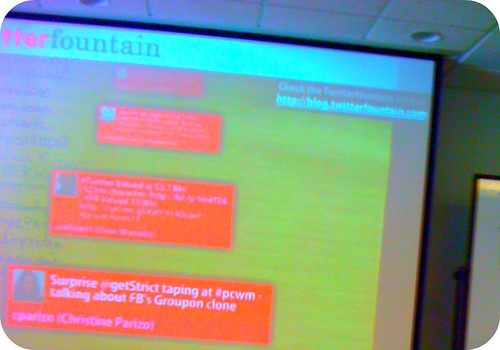 |
| The Twitter Fountain at PodCamp Western Mass. 2011 |
The climate seems clear: Having a presence on the major social media networks is a necessity in all industries, whether a business makes widgets or talks about said widgets’ feelings to make a profit.
Some industries, including restaurant and hospitality outfits, tourist destinations, and nonprofit organizations, have been front-runners in the social race. These subsets use social networking and media often and to great effect, treating it as a large piece of the marketing puzzle, and have had business-to-business success as well as consumer-level success as a result.
Essentially, those who are gleaning the most benefit from social media and networking have grasped that social B2B is a hot tap of best practices, good leads, and industry information, and that leads to new frontiers at all levels.
These are great models to follow. But even if the return on one’s investment of time, effort, and funds is still a blurry target for you and your business, it’s important to at least dip a toe in the shallow end of the social pool.
Here are a few reasons why:
1. Pages on facebook, LinkedIn, and Twitter, are consistently at the top of a search list when searching for a company name and as such increase the company’s online presence, name recognition, and SEO efficacy.
2. From a sales perspective, sales representatives with LinkedIn pages, Facebook profiles, or Twitter streams offer more ways for people to connect with them, be they prospects, vendors, or colleagues. These networks also work with one another: Facebook, Linkedin and Twitter accounts can be easily linked together to share information or easily promote news, photos, videos, and more with the click of a button.
3. The networks can be used to connect with both the media and the public without having to create two separate campaigns or streams of communication. That means the media can find and promote your news as easily as you can hob-nob with industry insiders.
4. When it comes to trade shows, social media can be used to publicize your booth and any special events your company is holding, while at the same time monitoring who’s been invited and who plans to stop by. Creating an ‘event’ on Facebook is the best example of this – invite your industry ‘friends’ to your booth or event, and in turn they can invite others as well. This adds to your network and also takes some of the impetus off of you when trying to get qualified folks to look at your products. It’s an outlet for fun things, too -– product giveaways powered by contests, trivia, or games encourage content creation by participants and interaction with the brand.
Twitter is often used as a ‘navigation tool’ at trade shows, too. Organizers will choose a special keyword (hashtag) that attendees and vendors can use, and this sets those messages apart and makes them searchable. Examples: “Flooring demo in 20 minutes at Booth 222 – #IWF”, or “They’re giving away free ice cream at the Suddekor table! #IWF”. Plus, if a vendor Tweets ‘10% off sale for our followers’ or something similar, it’s likely to be more effective than a static sign, because the people following you already want to hear what you have to say. It’s more targeted.
5. Social media also makes PR more dynamic. You can maintain your press kits and paper releases, but at the same time, have that information available via an online newsroom. Beyond just the text, online press releases can also include photos, links, contact info., and videos – and we already know, the trade publications love getting all the information we can send them.
Jaclyn Stevenson is the director of Public Relations and Social Media for Winstanley Partners. She recently caught a flying hibachi shrimp in her mouth to great cheers.


